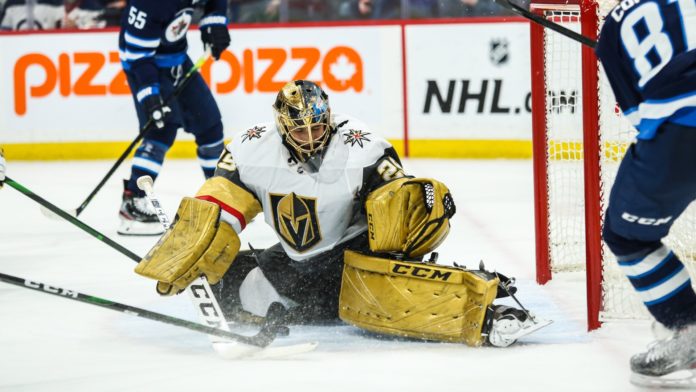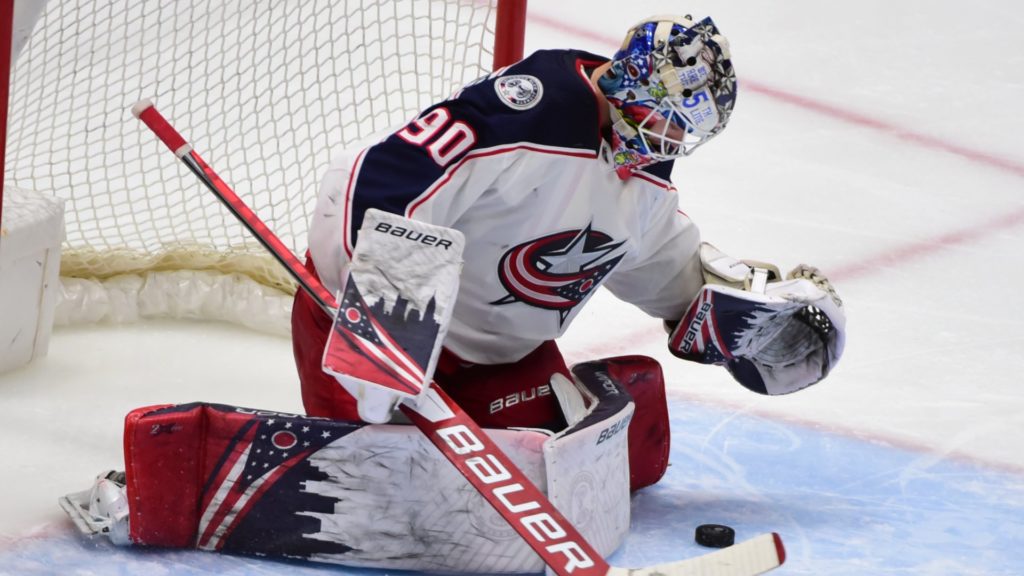
It’s no secret just how strange this NHL post-season is about to be. Fitting twenty-four teams into a new, condensed format will be the biggest adjustment but, unlike a usual playoff following an 82-game regular season, we’re looking at a refreshed group of competitors coming off one of the longest hiatuses we’ve ever seen.
As teams elect to rely on backups more than ever to ensure their starter is as rested as possible, we’ve seen more close goaltending battles than we’re accustomed to. That’s especially true this season, with teams still adjusting to their post-trade deadline lineups and trying to figure out the best path forward when the pandemic abruptly paused everything.
Some teams had goaltending hiccups from the get-go, relying on younger options to fill the gaps left by struggling veterans. A perfect example: the New York Rangers. Henrik Lundqvist’s best days are well behind him and Alexandr Georgiev wasn’t the answer as his replacement. Instead, the Rangers relied on Igor Shestyorkin, one of the best goaltenders to suit up in the KHL and a fresh face in the Big Apple at the age of 24. Shestyorkin has very few losses to his credit in seven years of pro hockey, and he exploded out of the gate with a 10-2-0 record to kick off his NHL career. A late-season car accident took him out of action before the shutdown, but the now-healthy netminder is back and ready to take over.
There’s only one question: is now the right time? With just 12 games played, Shestyorkin’s NHL tenure is the shortest among NHL playoff goaltenders. Can the Rangers trust him in the crease over Lundqvist, the team’s backbone for the past 15 years, with a Stanley Cup final appearance on his resume and very few chances remaining to earn another? Statistically, Shestyorkin was the best option between the pipes and deserves the starting gig, but the team could easily bet on experience if Shestyorkin struggles early on. The Rangers did utilize a three-goalie system for the second half of the year, so nothing is set in stone.
That’s just one situation, as the abbreviated regular season and ensuing hiatus have made for a few similar conundrums around the league. Here are a few of the most notable goaltending battles to watch this post-season:
Washington Capitals
Braden Holtby and Ilya Samsonov
The championship-winning vet and the young hot hand. In theory, this describes a duo any team would drool over. But for Washington, it creates more questions than answers.
Braden Holtby’s struggles have been well-documented this year, even if he managed to finish the regular season with a respectable 18-9-4 record. Among goalies with at least 1,000 minutes played – around 25 games minimum – Holtby’s save percentage at even strength was .905, ranking him an abysmal 49th out of 54 qualified goaltenders in what’s considered the most important game format by which to judge play. Using goals-saved-above-average, he falls down to 52nd at minus-14.70, while his high-danger save percentage places him at 50th with .786. Ilya Samsonov, on the other hand, finished 11th with a .927 SV, 13th with a 4.34 GSAA, and 22nd with a .835 HDSV.
What do those numbers mean? Holtby had a tremendously down year and was one of the worst full-time netminders in the NHL. Samsonov’s numbers weren’t spectacular by any means, but only Elvis Merzlikins (2019-20) had a better rookie season statistically within the past three years. Samsonov’s 16-6-2 record was impressive, especially since most of his losses came in the midst of the team’s terrible stretch to end the season.
If we’re relying simply on this season’s data, Samsonov is the right choice. But coaches rarely devalue playoff experience and Holtby was a vital cog in Washington’s 2018 Stanley Cup title. Samsonov was far from perfect this season and, while he’s played in some big events overseas, it’s a definite possibility that the Caps will go with the tried-and-true method. If Holtby – a pending UFA – is given first crack at the crease, he’ll be on a short leash after the rough season he had.
Vegas Golden Knights
Marc-Andre Fleury and Robin Lehner
Since the Golden Knights’ inception, Marc-Andre Fleury has been Vegas’ go-to man between the pipes. This arrangement has easily paid off, with Fleury finishing fourth in Vezina Trophy voting in each of the franchise’s first two years, and leading the team to the Stanley Cup final in 2018. But 2019-20 has been a struggle for Fleury, with his GSAA falling to a near-career-low of minus-6.50 and his .915 save percentage at five-a-side hockey placing him 40th among 54 goalies with at least 1,000 minutes played this season.
At the trade deadline, Vegas acquired Robin Lehner in a three-way deal with Chicago and Toronto, to help bolster the club’s net presence. Lehner was a finalist for the Vezina Trophy in 2018-19 and was having himself yet another spectacular season before the move. The Golden Knights clearly felt they had issues in the net behind Fleury, and Fleury wasn’t performing well enough to handle the load on his own. Will the Golden Knights sway from their Golden Boy? This may be the best opportunity the team has ever had.
Like with Washington, it’s going to be tough for Vegas to oscillate from experience. Fleury has three Stanley Cups to his credit – albeit just one as a starter – and he knows how to win games when they matter. Lehner has just 10 games of playoff experience over 10 years, and he looked quite human at times in last year’s run. The edge still goes to Fleury thanks to his history, but having two strong goaltenders capable of filling the starting role is certainly nice coming off a hiatus.

Columbus Blue Jackets
Elvis Merzlikins and Joonas Korpisalo
The Blue Jackets appeared destined to finish near the bottom of the standings after losing star goaltender Sergei Bobrovsky to Florida via free agency last summer. Joonas Korpisalo had limited experience as a starter and Elvis Merzlikins was a 25-year-old rookie coming out of the Swiss league. What possibly could go wrong? Not much, as it turned out, since both goalies were among the best in the NHL at different points this season. Korpisalo was originally supposed to partake in the 2020 NHL all-star game after one of the hottest runs of the season, before knee surgery took him out for an extended period of time.
Merzlikins, on the other hand, wasn’t trusted with a start on home ice until December. He subsequently posted five shutouts in less than a month to kick off the second half of the year and was, statistically, near the top of the world while Korpisalo was out. Merzlikins stumbled a bit down the stretch, suffering an injury of his own while the Jackets as a group struggled as their injuries continued to pile up.
Both goalies are healthy – and the rest of the battered squad is too – but who gets the edge in net? Merzlikins got hot late and it’s hard to suggest he wouldn’t get the first look, but Korpisalo was near perfect for a stretch before his injury, and he was around to witness Bobrovsky’s two Vezina Trophy seasons. Did Korpisalo pick up on how to handle the pressure? Perhaps, but even the team’s fanbase seems split as to who should earn the starting role in the play-in round against Toronto. The Maple Leafs have the edge in net with Frederik Andersen, so whoever gets the call for the Blue Jackets needs to be perfect.
Pittsburgh Penguins
Tristan Jarry and Matt Murray
In 2016, Matt Murray forced his way into the spotlight by stealing Marc-Andre Fleury’s starting job and leading the Penguins to the Stanley Cup, only to do it again the next year. Since then though, Murray’s tenure in Pittsburgh has been a rather rocky one, providing average stats while being unable to channel the early career glory that saw him win two Cups before completing his rookie eligibility. Murray was one of the worst statistical goaltenders this season, with his .904 SV (50th) and minus-12.07 GSAA (49th) placing him near the league’s bottom in the most important categories, out of 54 goalies with at least 1,000 minutes played.
Tristan Jarry was spectacular early in the going, placing himself near the top in those same categories for the majority of the year, even with the Penguins struggling to stay healthy. But Jarry has limited experience as a starter and, with 18 goals against in four losses to end the season, there was some doubt as to whether he can handle a post-season run. Still, with Murray having the worst season of his career and wallowing among the bottom-feeders overall, the Penguins should elect to go with Jarry to kick things off. Having someone with nearly 50 games of post-season experience in a short career is always a positive, but only if Murray can muster his previous dominance.
Calgary Flames
David Rittich and Cam Talbot
This was supposed to be the year when David Rittich emerged as the true No. 1 in Cowtown. For the first half of the season, he lived up to the task, representing the Pacific Division at the NHL all-star game and doing his best to save what was turning out to be a troubling campaign for the Flames.
As the season went on, however, things got worse for the Czech netminder. His GSAA fell from 1.68 to minus-4.35 this year, with his .915 SV and 2.63 goals-against average at five-a-side placing him in the middle of the pack. Meanwhile, David Rittich’s second-half record of 7-7-1 was easily vanquished by Cam Talbot’s 9-3-1 run, with Talbot’s numbers sitting not too far behind Vezina Trophy favorite Connor Hellebuyck’s in Winnipeg.
If we’re basing the playoff starting role on second-half performance, Talbot is the right choice. At his very best though, Rittich is the main man, and the extended time off could have been exactly what he needed to recharge and take control. This ignores the late-season brilliance that made Talbot one of the best goaltenders down the stretch, but it’s always preferable to trust your top dog. Should Rittich be shown that respect, he can’t have an off night in what should be a close battle against Hellebuyck and the Jets.


































